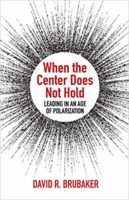
Given the extreme polarization that now infects American society, many wonder what they can do to reduce divisions in families, communities, and congregations. Fortunately, there are strategies any of us can adopt to become agents of depolarization. They range from the intrapersonal (changing attitudes and behaviors) to the systemic (advocating for social change), but all can be implemented at the local level. All the ideas that follow come from When the Center Does Not Hold: Leading in an Age of Polarization, a book I wrote with several colleagues in 2019, published by Fortress Press.
1. Honor Dignity
History has repeatedly demonstrated that before people in one group can be compelled to kill innocent human beings in another group, they must first dehumanize them. This is why it is particularly dangerous when leaders use dehumanizing language against racial, religious, or sexual minorities, given these groups’ vulnerability. But the answer is NOT to respond in kind. The work of Donna Hicks (Dignity and Leading with Dignity) reminds us of how critical it is to interrupt such language when it first surfaces. We may not be able to respect someone’s distorted thinking, but we still have an obligation to honor their inherent dignity as (in my own theology) a beloved child of God.
2. Broaden Binaries
This idea comes from my son Everett Brubaker, who wrote the chapter in our book titled “Communicating across the Divide.” Everett observes that “the language we speak is a powerful mediator of how we understand and describe our world.” The problem with the English language is that it is replete with binaries—“either/or,” “all or nothing,” “for or against,” etc. Everett urges “mindfulness” in our communication, along with the ability to think in terms of a spectrum of views on any issue, not just two extreme options. Everett suggests that when communicating with others we must be mindful of the audience with whom we are communicating, as well as of the messenger doing the communicating.
3. Self-Define
Speed Leas, former senior consultant with the Alban Institute, observed that two styles of leadership tend to get congregational leaders in deep trouble. The first is authoritarianism—a leader’s insistence on “my way or the highway” that inevitably divide a congregation. But the second, which causes just as many failed pastorates, is a completely undefined leadership style. Never knowing what a leader stands for, others in the system tend to see that person as weak and unprincipled. Leaders can take a position while inviting disagreement, but effective leadership in a conflicted environment does sometimes require a leader to take a stand.
4. Invite Disagreement
Conflict-savvy leaders move toward conflict when it’s small, rather than avoid it and allow the conflict to grow. They do this in two ways: First, they invite disagreement by encouraging members of the system to come to them directly when they have a concern. Second, such leaders take the initiative to approach others, rather than avoid them, when they sense strain in the relationship. Such leaders model direct engagement and encourage others to do likewise.
5. Manage Polarities
When a system polarizes, it’s often because the two ends of the spectrum are unable to hold together competing truths or realities. A classic example is the ongoing battle between those who advocate for “individual freedom” and those who call for “community responsibility.” These slogans express the fundamental human need for both autonomy and affiliation. As consultant and author Barry Johnson suggests, the challenge is not to “resolve the conflict” between these two perspectives, but to “manage the polarities” that exist within the system.
6. Address Trauma
Our families, congregations and communities may also need assistance in naming and recovering from past or ongoing traumas that spawn polarization. Author Carolyn Yoder suggests that if you want to know if unaddressed trauma is affecting you, your community, or your organization, observe the quality of relationships people have with themselves and each other over months, years, and centuries. If you see evidence of reactive relationships and either escalating conflicts (fight) or chronic avoidance (flight), unresolved trauma may be at the root of the polarization. Uncovering and addressing the underlying trauma in the system itself may be a necessary step towards congregational or community health.
7. Reduce Inequality
The single greatest driver of political polarization may be growing economic stratification. As the gap between the richest and poorest citizens increases, political polarization rises as well. Those countries with the greatest gap between the rich and the poor (such as Brazil and South Africa) tend to experience the highest levels of polarization, whereas countries with the smallest wealth gaps (such as those in northern Europe) experience lower levels of polarization.
8. Understand Identity
In social identity theory, the groups with which we identify are an important source of both belonging and self-esteem. Thus, if individuals feel that the status of their identity group is threatened, they are particularly likely to exhibit hostility toward other groups. Social identity theory and its concept of status threat help us understand why voters might respond to a leader who promises to reverse the real or perceived declining status of their identity group.
9. Build Coalitions
Of all sectors of civil society in the United States today, religious congregations gather the most people, and thus are the most significant. Therefore, there is no more important venue where we can work to rebuild civil society than in and among religious congregations. Ecumenical cooperation and interfaith collaborations, such as the organization Faith in Action (based in Harrisonburg, VA), are primary mechanisms for rebuilding civil society in any community. As we restore civil society community by community, our society will also begin to heal.
10. Imitate Jesus
The diversity among Jesus’ disciples, which certainly included more than the 12 men named in the Christian scriptures, were startling to Jesus’s contemporaries. Teaching and healing were standard practices for rabbis of Jesus’s day. But including women, a tax collector, and a zealot among one’s devoted disciples? And commanding followers to love even their enemies? Jesus’s “love for enemies” teaching came with a twist. Love for enemies included a commitment to challenge their dehumanizing behavior and the oppressive systems that supported such behavior. We must combine efforts to dismantle oppressive systems with a commitment to honor the dignity of all those trapped in such systems.
It took 40 years to reach the stark level of polarization now rampant in our society, and thus it will take some years to reweave our connections. But all of us can commit to becoming agents of depolarization in our own communities and congregations. Breaking down the walls of division will require not avoidance but engagement—always with a high regard for the dignity of those with whom we disagree.
David Brubaker has consulted with organizations and congregations in the U.S. and a dozen other countries on organizational development and conflict transformation. He is the author of Promise and Peril, on managing change and conflict in congregations, and When the Center Does Not Hold, on leading in an age of polarization. David recently retired from his role as Dean of the School of Social Sciences and Professions at Eastern Mennonite University, and is now a Professor Emeritus of Organizational Studies.


